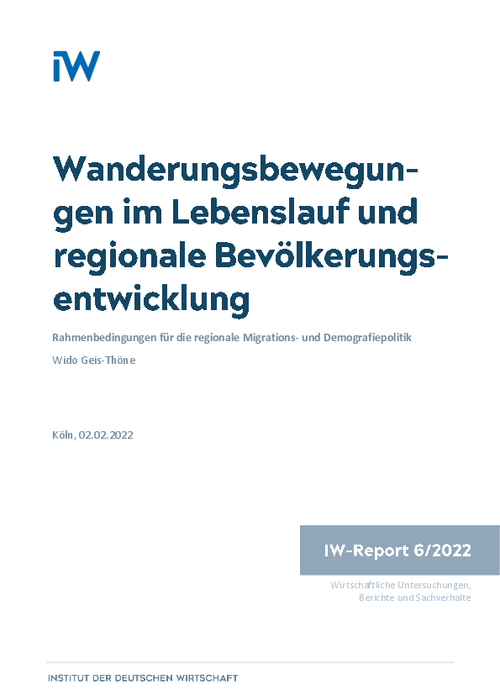Against the background of demographic change, Germany is increasingly dependent on immigration to secure growth and prosperity. In this context, the actors at the municipal level must also become active and shape their own regional migration and demographic policy. This is particularly the case in regions affected by high emigration.

Life course migration and regional population development

Against the background of demographic change, Germany is increasingly dependent on immigration to secure growth and prosperity. In this context, the actors at the municipal level must also become active and shape their own regional migration and demographic policy. This is particularly the case in regions affected by high emigration.
In these regions, efforts should first be made to retain the young people who grew up there or to win them back after graduation. For this purpose, good living conditions for youths and young adolescents are very important, as they can strongly shape attitudes towards the region. Return initiatives and targeted marketing of the region as an attractive place to live and work can also be helpful.
A major problem at this point is that it is difficult to grasp the actual extent of the problem, as migration movements follow very different regional patterns in the life course. Upon reaching adulthood, there is initially a strong movement to districts with large academic institutions, which is partially reversed in the middle of the third decade of life. Now the more rural university locations are losing population again, whereas the large metropolises continue to experience a strong influx. In the fourth decade of life, this changes again and a movement from the larger cities to the surrounding areas can be observed. An indicator that looks at all these migration movements can be formed by linking the population changes in the various birth cohorts over the last five years. If one looks at the resulting changes in population sizes between the ages of 10 to 14 and 45 to 49, one arrives at values in the double-digit range for most districts, which are highly relevant for the demographic development as a whole. On the one hand, there is the Saale-Holzland district with -37.7 per cent and the Lüchow-Dannenberg district with -36.9 per cent, and on the other hand the district-free cities of Leipzig with +221.4 per cent and Potsdam with +197.1 per cent. The other large metropolitan areas also experience a strong immigration, whereas the rural areas in eastern Germany are losing a lot of their population. Similar regional patterns and orders of magnitude can also be found when looking at the development of the birth cohorts 1981 to 1985 between the years 2000 and 2020. However, the overall picture is clearly more negative, as the historically exceptionally strong immigration of recent years has less impact here.
If one extrapolates the development of the working-age population between 20 and 64 years in the years 2020 to 2030 on the basis of the changes of the last five years, a strong urban-rural and west-east divide is found. The most positive values are found for the independent cities of Leipzig with +18.3 per cent and Potsdam with +17.6 per cent, and the most negative for the districts of Saalfeld-Rudolstadt with -26.4 per cent and Spree-Neiße with -26.2 per cent. It should be borne in mind that in the current five-year period on which the calculations are based there has been very strong immigration from abroad. If we look only at nationals, the picture is clearly more negative in most regions, both in terms of total immigration over the life course and in terms of the development of the working-age population. However, regional demographic and migration policy can and should also address immigration from abroad. Especially for smaller cities and municipalities, it can make sense to focus on only one region of origin. This way, it is possible to enable the development of a strong ethnic community, which can have a very beneficial effect on further immigration and the continuance of immigrants in the region.

Life course migration and regional population development

More on the topic

Record immigration not only due to flight from Ukraine
In 2022, more people immigrated to Germany than ever before in the history of the Federal Republic. Around 1.46 million more people moved here than left the country, which is more than a quarter more than the previous record of 1.14 million from 2015.
IW
Immigration from Latin America: Successes and potential for securing skilled workers
Against the background of the baby boomers leaving the labour market, Germany will be increasingly dependent on skilled workers from abroad in the coming years in order to secure growth and prosperity.
IW